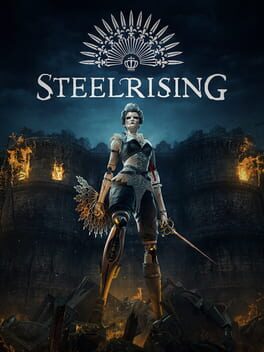rentheunclean
BACKER
I use the whole scale
⭐ - I do not like it
⭐⭐ - It is OK
⭐⭐⭐ - I like it
⭐⭐⭐⭐ - I really like it
⭐⭐⭐⭐⭐ - It is amazing
Note: ⭐⭐ is not a bad score, it either means that:
- I Like some parts of it, but there are some fundamental problems preventing me from recommending it without caveats
or
- It is just not doing anything particularly interesting, but it isn't actually bad.
Badges

Gone Gold
Received 5+ likes on a review while featured on the front page

GOTY '23
Participated in the 2023 Game of the Year Event

Well Written
Gained 10+ likes on a single review

Pinged
Mentioned by another user

Adored
Gained 300+ total review likes

GOTY '22
Participated in the 2022 Game of the Year Event

Shreked
Found the secret ogre page

Popular
Gained 15+ followers

Organized
Created a list folder with 5+ lists

Donor
Liked 50+ reviews / lists

Loved
Gained 100+ total review likes

Best Friends
Become mutual friends with at least 3 others

Roadtrip
Voted for at least 3 features on the roadmap

3 Years of Service
Being part of the Backloggd community for 3 years

N00b
Played 100+ games

GOTY '21
Participated in the 2021 Game of the Year Event

Noticed
Gained 3+ followers

Liked
Gained 10+ total review likes
247
Total Games Played
022
Played in 2024
190
Games Backloggd
Recently Played See More
Recently Reviewed See More
Sekiro is about parrying in a way that no other souls game is. You will have to rewire your Souls habits to succeed here, but a couple of smart decisions make the onramp manageable. Parry windows are extremely generous and failing usually just means you block (which has other negatives). It is a super interesting combat system that I had a good time learning, despite some of the cracks showing by midgame.
Enemies have poise that you parry, deflect, and clash your way through, whereupon you can score an execution, killing them immediately. Bosses take 2 or 3, usually marking specific delineations for their phases. This is a cool reward moment that makes these fights feel like balletic swords duels when it works, clashing back and forth as you learn their attacks and exploit them. Fights like Jinsuke Saze and O'Rin of the Water feel incredible as you learn their attacks and execute them perfectly. Your first attempt will be 5 minutes of healing, defending, and looking for opportunities while your winning attempt will be 30 seconds of attacks, parries, and executions. I haven't gotten quite this feeling of complete mastery from any other Souls game.
This is unfortunately undercut in many fights by the fact that poise regenerates very quickly when an enemy is at full health, so you will spend much of the battle trying to deal vitality damage to them so that you can finally parry them into an execution. It becomes a tedious and rote exploitation of their positioning and movement that simply doesn't work.
Some unclear UX around perilous attacks makes things a bit more frustrating and fiddly than it probably should be which is exacerbated by the camera and lockon system not playing that nicely with multiple enemies (each of which is doing a perilous attack on you, good luck!).
The lack of any particular ability to customize your build gives the game a very intentional feel, but also made me feel locked into playing a particular way that could sometimes be more frustrating than fun.
The negatives weren't quite enough to ruin the game for me. I did cheat my way through the final boss and don't feel bad about it.
Narrative in Sekiro is trying to be more linear and straightforward than other From games and they don't quite deliver. There is a coherent throughline, but a lot of what happens and why is either unclear or based in some lore or actual Japanese history I don't understand. There are side areas, but the progression here feels very linear, with basically one way to go to proceed and a lot of story-based area gating. It is fine for what it is, but trades From's strength (narrative through world-building and inference) for their weakness (narrative through direct linear plotting).
I love the style and look of this game. It has muted visuals punctuated by bold colors and environments that are grounded but extremely surreal. Enemies are all based in Japanese history and myth which gives things an authentic and compelling edge while allowing giant serpents, apes, and monkeys firing rifles to exist believably along with spear wielding samurai and agents of the unexplained "Interior Ministry."
Along with Bloodborne, this probably has the most striking and impressive look of any From game.
I like Sekiro quite a bit, but some of the uneven difficulty, combat system weirdness, and narrative stumbles do mar the experience for me. It is worth playing to see how different this sort of combat can be, but don't feel bad about cheating if things get a bit too frustrating.
There are hub worlds here with a heavy emphasis on puzzles consisting of finding keys or switches hidden in disparate areas and slowly unlocking more and more of the levels. This gives the game a pretty unique feel even though the weapons, enemies, and story don't really have much to say.
Hexen II diverges from Hexen in that it is actually a Quake-like, rather than a Doom-like. As you might expect this makes things more 3D, more hectic, and quite a bit more ropey. I have never really liked the feel of Quake and Hexen II doesn't do much to fix that, unfortunately. Enemies are incredibly lethal and by the end they are repeating the same few with more hit points. I didn't find much of interest by this point, and it just felt like a slog (I turned on godmode for the final level and I don't regret it).
World design here is strong at times, but inconsistent and the level design can be tedious. I enjoyed the first levels, Blackmarsh, quite a bit and they somehow manage to deliver on the feel of a medieval fantasy quest more completely than Hexen does. There are dungeons, granaries, and shops filled with enemies you can believe have just invaded and driven out the villagers.
Upon leaving this area, you go into a series of differently themed levels (Aztec, Egyptian, and Roman) that took me out of things pretty heavily. Only the Roman one really worked for me, but in general the "collect the random things in this area" nature of the game was just more apparent in these more abstracted areas that lacked the specific world-building of Blackmarsh.
Things do look pretty good, with each area having a distinct, identifiable motif and well done environment art. I do still like the look of pseudo 2D sprite based first person games better by this point in shooter history, but Hexen II looks fine for what it is.
There are four classes here that all seemed pretty interesting, though I only played as the Cleric. Weapons are more like Heretic than Hexen, with nothing to really push me to utilize their specific properties and no enemy behaviors to really mix things up.
We have a hammer, an ice wand that is basically like the mage weapon from Hexen, a staff that is a rocket launcher (phoenix staff from Heretic), and a sun staff that shoots a beam that passes through enemies and bounces off walls. The sun staff was definitely the most interesting, but usage in this game felt mostly like Heretic does -- I just used whichever I had ammo for without much consideration.
Items come back with the same problems. There are a ton of them. Keeping track of what they do is difficult. Scrolling through your massive list to use them is a futile endeavor.
Enemies don't have many unique behaviors, and all have so much health that I couldn't see any discernable weaknesses on display. This is the weakest part of Hexen II for me and the enemy design and interactions in general just feel too much like Quake for me to really enjoy it.
Interesting game that tries to do a bit more with the Hexen formula but largely didn't come through for me. If the whole game was at the quality level of Blackmarsh and the weapons and enemies were a bit more interesting I would have liked it much more I think.
The gameplay is fairly standard action RPG combat that is responsive, but can feel a bit loose at times. Defense has an emphasis on dodging and the game is very permissive here, with generous iframes and stamina usage. I used a fast, dual-wielding elemental build and found the difficulty to be essentially negligible for the whole game, which is fine -- I am not playing a Spiders game for the extreme challenge and, to be honest, I don't know if their mechanics can really deliver.
Combat centered around elemental effects for me (I think other builds would be straight damage or poise breaking), and each of them has a unique effect that is fun to try to play around and stack (though ice is just overpowered). Enemy resistances also have a big impact on which you can lean on, so type matching can keep things a bit interesting even when the lack of enemy variety becomes apparent.
There is a cool mechanic that lets you hit a button when you run completely out of stamina to gain it back instantly, a bit like a perfect reload in Gears of War. It puts a stacking debuff on you, but if you play well it can allow you to have near infinite stamina, which feels satisfying and effective. A weird bug where sometimes it gets in a state where you can't regen and can't trigger the recovery does sour it a bit, unfortunately.
This game is the best playing of Spiders games thus far and I was legitimately surprised by how much I enjoyed the gameplay. It is just expressive enough to be fun and not so punishing that the jank and inexactness of the mechanics feels bad.
Steelrising looks good. I don't think I like it visually quite as much as Greedfall and it definitely feels like there is less actual variety to the environments -- you will only ever see French cities, gardens, and some rural areas. They nail a certain level of oppressiveness here that matches the chaotic French Revolution setting very well. Steelrising doesn't shy away from the horror of the historic event even while injecting it with a weird clockwork army twist.
I really like the designs of the machines here, especially in contrast to the player character, Aegis. Enemy machines are mostly jangly weirdos who flop around, making their attacks initially feel very unpredictable and hard to deal with. Aegis (as a dancer) is fluid and lets you feel like you are literally dancing circles around enemies while you fight them. It is a cool take on this clockwork aesthetic that feels unique as compared to Steelrising's contemporaries.
As I mentioned earlier, there really aren't enough enemy types in the game, with many of them being reused with different elemental types. In general, the game content is just stretched too thin. This is pretty surprising, as I felt like Greedfall managed to make really good choices about how to use its content and didn't overstay its welcome quite as much as Steelrising manages to.
The story here is pretty wild and Spiders leans all the way into it. This is a retelling of the French Revolution (including all of the major historic players) but with Louis XVI using a clockwork army to enact his oppression on the people. Things get a bit weird with the members of Estates General speaking at length about liberty and politics and country while an army of automatons is killing everyone, but I am here for it. You make some choices about which factions to prop up that I am sure I would have understood if I knew anything about history. I went with Lafayette because he seems like a cool dude in Hamilton, but he is probably a fascist, so, you win some you lose some.
Spiders is a French studio and it is great to see them tackle their home turf like this. You can see the passion and lived experience in their capturing of the city of Paris and the general feel of the environments.
All the acting is fairly well done, despite the animation only delivering about 30% of the time (again, budget). There are a couple of standouts such as Nicolas Flamel, who is over the top in just the right way. I was also very impressed with Aegis as she (somewhat predictably) becomes less robotic over the course of the game and the acting choices are subtle and believable with a final performance that is super solid.
I liked Steelrising and am happy that it continues Spiders' general upward trend. I think the world and storytelling in Greedfall is a bit better, but the gameplay in Steelrising is much better than any of their previous games and I had a good time throughout!




